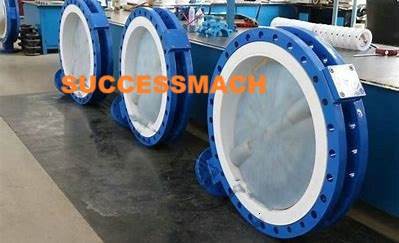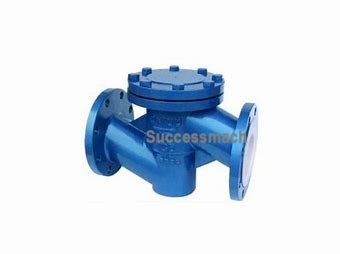Zhengzhou Success Machinery Co.,ltd - Professional valve manufacturer
News Events
Latest News
Fluorine lined valve corrosion resistance and use of contraindications
Release time:
Jul 29,2025
Fluorine lined valves as industrial piping system to deal with corrosive media in the key equipment, its corrosion resistance and the use of specifications directly affect the safe and stable operation of the system.
We are from the performance of corrosion resistance and the use of contraindications in two aspects for detailed elaboration.
一、The corrosion resistance of fluorine lined valves is mainly manifested
The core anti-corrosion advantages of fluorine lined valves stem from its lining material - polytetrafluoroethylene (PTFE, commonly known as the “plastic king”) chemical inertia, specifically expressed in the following six aspects:

(1) Broad-spectrum resistance to strong acids and alkalis
The bond energy of carbon-fluorine bond in the molecular structure of PTFE is extremely high (485kJ/mol), which far exceeds the destructive energy of most chemical reagents, so it can withstand corrosive media with a wide range of concentrations.
For example, when dealing with 98% concentrated sulfuric acid, 30% nitric acid, 50% sodium hydroxide and other strong corrosive solutions, the fluorine lining layer can remain stable for a long time, and will not be dissolved, dissolved or chemically decomposed. In the chemical industry, the service life of fluorine lined valves in pickling section and electroplating waste treatment system is usually 5-10 times of ordinary metal valves.
(2) The anti-permeability of organic solvents
Organic solvents (such as methanol, ethanol, acetone, toluene, etc.) have a dissolving or penetrating effect on most of the metal and non-metallic materials, but the molecular structure of PTFE is compact and nonpolar, which can effectively block the penetration of organic solvents.
In the solvent transportation pipeline in the pharmaceutical industry, fluorine lined valves can avoid corrosion of the valve body due to media infiltration, and at the same time prevent media contamination, in line with GMP (Good Manufacturing Practice) requirements.
(3) Stability to high temperature corrosive media
In the temperature range of -200℃ to 260℃, the chemical properties of PTFE are almost unchanged. In contrast, rubber lined valves may be aging above 80 ℃, while the corrosion rate of metal valves at high temperatures will be significantly accelerated.
In petrochemical cracking units, fluorine lined valves can withstand long-term corrosion of chlorinated hydrocarbon media at 180 ℃, while stainless steel valves under the same conditions usually pitting and perforation occurs within 3-6 months.
(4) Resistance to strong oxidizing gases such as wet chlorine gas, fluorine gas, etc.
Wet chlorine gas (with trace moisture) generates hydrochloric acid and hypochlorous acid, which is extremely corrosive to metal materials, and it is difficult for even Hastelloy alloys to withstand it for a long time.
The PTFE lining of fluorine lined valves will not react chemically with wet chlorine gas, and its service life can be more than 5 years in chlorine gas transportation pipeline in chlor-alkali industry.
(5) Corrosion resistance to media containing fluoride ions
Fluoride ions will react chemically with most metals (such as aluminum, magnesium, titanium, etc.) to produce soluble fluoride, resulting in valve corrosion. However, PTFE does not react with fluoride ions, and fluorine lined valves are the only feasible choice for hydrofluoric acid delivery systems in the fluorine chemical industry.
(6) Safety for food-grade media
PTFE is non-toxic, odorless, in line with FDA (U.S. Food and Drug Administration) standards, and does not adsorb impurities in the medium. In the food and beverage industry, acid and alkali cleaning pipeline, fluorine lined valves can withstand the corrosion of the cleaning fluid, but also to avoid contamination of food, to protect product safety.
二、The use of fluorine lined valves in the process of taboos

(1) Prohibit the use of over-temperature
Although the theoretical upper limit of the use temperature of PTFE is 260 ℃, in practical application, when the temperature exceeds 200 ℃, its mechanical strength will be significantly reduced, which may lead to deformation of the lining or fall off.
For example, in the piping system with steam tracing heat, if the steam temperature exceeds 200℃, direct contact with the fluorine lining layer will cause PTFE to undergo thermal aging, and lining cracking will occur within 3-6 months.
Therefore, the actual use temperature of fluorine lined valves should be controlled between -10℃ and 180℃, and local high temperature should be avoided (e.g. open fire baking, steam blowing).
(2) Avoid violent temperature shock
When the valve is suddenly exposed to low temperature medium from a high temperature environment (or vice versa), the difference in the coefficient of thermal expansion between the PTFE lining and the metal valve body will lead to a concentration of stress at the interface, which may trigger delamination of the lining.
For example, in the northern region in winter, if the fluorine lined valve at room temperature is directly connected to the liquid oxygen pipeline at -30℃, the lining may be cracked due to violent contraction.
Therefore, in the case of drastic changes in temperature, the valve needs to be preheated or pre-cooled slowly, and the rate of temperature change should be controlled within 5 ℃ / min.
(3) Prohibit to use in vacuum condition or negative pressure system
PTFE has low strength (tensile strength about 20-30MPa), in negative pressure environment, the lining may bulge or tear due to the external pressure is greater than the internal pressure. In the vacuum distillation system, special fluorine lined valves with reinforced structure should be used, or change to metal bellows sealed valves.
(4) shall not be used for high-speed flow media containing hard particles
Although PTFE has a certain degree of abrasion resistance, when the medium contains hard particles with a diameter greater than 0.5mm (such as quartz sand, metal chips) and the flow rate of more than 3m/s, the particles will be scouring the surface of the lining abrasion, resulting in seal failure.
In the slurry transportation pipeline in the mine, ceramic lined valves should be preferred to fluorine lined valves.
(5) Avoid long-term half-open state
When the valve is in a half-open state, the medium will form a vortex between the valve flap and the lining, resulting in increased local scouring.
For example, fluorine lined globe valve in the half-open state, within 3 months there may be localized wear and tear of the lining, while the service life of the fully open or fully closed state can be more than 3 years. Therefore, fluorine lined valves should not be used as a valve to regulate the flow, should only be used to cut off the medium.
(6) Prohibit the use of sharp tools to clean up the lining surface
In the maintenance of the valve, if the lining surface is found to have media residue, shall not use wire brushes, scrapers and other sharp tools to clean up, so as not to scratch the lining. The correct approach is to use a soft cloth dipped in alcohol or water to gently wipe, for stubborn stains, ultrasonic cleaning can be used to ensure that the lining surface intact.
(7) Avoid strong assembly during installation
The flange sealing surface of fluorine-lined valves usually adopts rubber or PTFE gaskets, and if the flange bolts are tightened forcibly during installation (more than 1.5 times of the specified torque), it will lead to deformation of the lining under pressure and even cracks. Torque wrench should be used to tighten the bolts evenly in diagonal order, reference torque value: 30-40N-m for DN50 valves, 60-80N-m for DN100 valves.
Fluorine-lined valves have irreplaceable advantages in corrosive media treatment by virtue of the excellent chemical inertness of the PTFE lining, but the use of contraindications must be strictly adhered to, so as to give full play to the advantages of its performance and prolong the service life.
keywords
Previous Page:
:Next Page
Previous Page:
Next Page:

Follow Us
Zhengzhou Success Machinery Co.,ltd
TEL:+8618595868771
E-mail:sales@successmach.com
Address:98-1 Dengfeng Road, Shangjie District, Zhengzhou City, Henan Province

